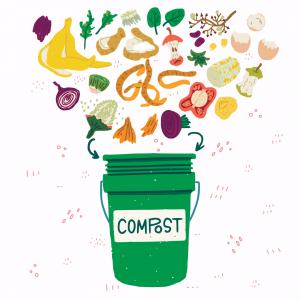
Composting Options, No Matter Where You Live
Any serious gardener knows the benefits of turning organic matter into compost. It’s rich in nutrients that improve soil and grow better food, without chemical fertilizers.
Now, composting is gaining interest far beyond readers of the Farmer’s Almanac. Across the country, people are paying more attention to how much waste they produce and exploring environmentally-friendly ways to reduce their footprint.
Enter composting services.
Numerous compost pick-up services now operate in major metropolitan areas like New York, Chicago, and Boston, where many customers live in large, multi-unit buildings and single-family residences with small or non-existent garden space.
But the trend isn’t limited to densely populated areas. You’ll also find compost pick-up services in such diverse locations as Cedar Rapids, Iowa and the north shore of Oahu, Hawaii.
According to the ReFED, 52 million tons of food is sent to U.S. landfills each year, where it consumes 21 percent of all landfill volume. Diverting that waste into composting facilities could reduce over 2.6 million tons of greenhouse gases and create 9,000 jobs.

How Does it Work?
Compost pick-up services have unique guidelines. In most cases, users follow similar steps:
1. Start with an empty bucket.
Composting services typically provide a 5-gallon container with a tight-fitting lid, which you can store indoors or outside.
2. Add your scraps.
Toss in food waste, like banana peels, corn husks, eggshells, and melon rinds. Other plant-based products can also be included, such as coffee grounds, wine corks, and paper.
While gardeners with backyard compost piles steer clear of meat and dairy products, many pick-up services can accommodate them. If yours does, go ahead and add meat scraps, bones, soured milk, and any leftover meat or cheese that has turned moldy to your container.
3. On pick-up day, set out your bin.
Place your bin in the agreed-upon pick-up location. Typically, you don’t need to be home for pick-ups. You’ll find a new, clean, storage container waiting for you.
Services operate on different schedules, but weekly, bi-weekly, and monthly pick-ups are standard options. Prices vary, depending on your schedule and location. Since less trash is going into your garbage, you may be able to reduce your trash collection fees and offset the cost of compost pick-ups.
4. Decide who gets your compost.
Some services give you the option to have composted material returned to you, so you can use it in your container gardens and raised beds, or spread it around landscape plantings.
In many cases, you also have the option to donate your compost to local community groups dedicated to growing food given to food banks and charitable organizations.
Drop-Off Sites
Instead of hiring a compost pick-up service, you may prefer taking your food scraps to a collection site. Farmers’ markets and community gardens are frequent drop-off locations. Some are free, while others charge a nominal fee.
Like pick-up services, drop-off sites aren’t limited to densely populated areas. In Alaska, for example, Haines Compost offers a free drop-off service for its roughly 2,000 residents. They say they’ve composted over 32,000 pounds in the past year.
Finding Providers
CompostNow maintains a directory that includes well over 100 compost pick-up services scattered across the U.S. and Canada.
It’s an excellent place to start, but some organizations don’t appear on their list. If you don’t find anyone serving your area, do an independent search for local groups. For example, in Little Rock, Arkansas, you’ll find The Urban Food Loop, which offers weekly pick-ups for $31/month.
Many composting providers serve both residential and commercial customers. While they all share a vision of reducing landfill waste, some are also supporting other causes. For example, Combat to Compost is a Veteran-owned business operating in Maryland, D.C., and Virginia.
DIY Options
Maybe you love the idea of composting but cringe at the thought of adding another monthly bill to your already tight budget. Or, the idea of hauling your food scraps across town to a drop-off site may sound too bothersome.
There are other ways to embrace urban composting, especially if you plan to use the “black gold” that comes out of your kitchen. Here are two space-friendly options:
Worm composting - Purchase (or make) a vermicompost bin and add scraps of paper, a little dirt, and some worms. Then, add food scraps and watch the worms turn the scraps into compost. It’s a fun, kid-friendly project.
Outdoor composting bins - Traditional, rotating compost bins are relatively large. It’s possible, however, to find smaller, space-friendly options. For example, the 17-gallon Envirocyle bin is less than two feet tall.
Regardless of what method you choose, composting your food waste can be satisfying on many levels—good for your garden, good for your community, and good for the planet.
